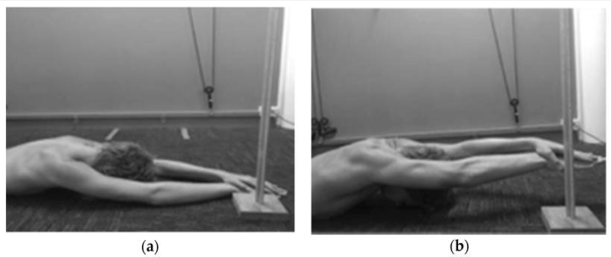Combined Elevation Test
Original Editor - Your name will be added here if you created the original content for this page.
Lead Editors
Introduction and Purpose[edit | edit source]
The Combined Elevation Test (CET) is a musculoskeletal screening technique originally developed by Blanch that involves a synchronized movement of thoracic extension, glenohumeral joint (GHJ) flexion, scapula retraction and upward rotation.[1][2] It replicates the streamline position in swimming required to reduce drag force and is commonly used to assess
- the strength of upper extremity and upper back
- flexibilty of shoulder (glenohumeral joint and scapulo thoracic joint) and thoracic spine. [3]
It has been widely used as assessment tool in various sports other than swimming such as cricket, rugby union, triathlon and surf lifesaving.[3]
Sport-specific musculoskeletal screening techniques (MSTs) are used in
- the identification of intrinsic risk factors for injury
- determining whether a patient can achieve a minimum standard for participation in a particular sport and
- to assist in appropriate goal setting for performance enhancement.[4][1]
Technique[3][edit | edit source]
Equipments required:[edit | edit source]
A measuring stand with a 1 mm incremental scale or measuring tape.[3]
Procedure:[edit | edit source]

- Participants were required to lie prone on the floor and assume a streamline swimming position. They were then asked to place their forehead, chest, hips, knees and feet on the floor. Forehead contact with the floor was used opposed to chin contact.[5][3]
- Instruction was then provided to assume a posture with their left hand on top of their right: elbows, wrists and palms straight and fully extended. Participants were required to hold a neutral wrist position, determined by the position of the metacarpals in relation to the ulna. Measurements were only taken when the patient’s metacarpals were aligned with the ulna in the sagittal plane.
- Participants were then instructed to maximally raise their arms away from the floor, while their forehead, chest, pelvis, and feet maintained contact with the floor.The perpendicular distance between the base of the metacarpo-phalangeal joint (MCPJ) of the third finger and the floor was then measured.The height of the base of the measuring stand was added to each measure taken.
- Three sub-maximal attempts were performed as a warm up to familiarize the participants with the movement required. Following the warm up, each participant performed three maximal efforts of the CET. A rest period of 10 s between each performance was given and measurements were then collected.[3]
Evidence[edit | edit source]
Normative value[edit | edit source]
According to the Blanch ( 2004), a appropriate range for the combined elevation test is between 5 and 15 degrees where angle measured is the angle between the line of the humerus and the horizontal.[1]
Based on the study done by Furness et al. ( 2018) in the age groups ranged from 8 to 18 years old, overall average CET score for male and female were 19.38 +/-7.53 cm and 20.09+/- 7.89 cm respectively.[4]
Psychometric properties[edit | edit source]
Dennis et al. (2008) showed good intra- and inter-rater reliability when using the CET (ICC 0.89 and 0.97, respectively) among 10 cricket players.[7]
Furness et al. (2018) showed excellent intra-rater with Intra-class Coefficient Correlation(ICC) of 0.991 with 416 participants ( swimmers and non- swimmers).[4]
References[edit | edit source]
- ↑ 1.0 1.1 1.2 Blanch P. Conservative management of shoulder pain in swimming. Physical Therapy in Sport. 2004 Aug 1;5(3):109-24.
- ↑ 2.0 2.1 Furness J, Schram B, Corea D, Turner Z, Cairns H. The Combined Elevation Test (CET) in Adolescent School Children: A Pilot Study. Sports. 2018 Sep;6(3):64.
- ↑ 3.0 3.1 3.2 3.3 3.4 3.5 Furness J, Schram B, Corea D, Turner Z, Cairns H. The Combined Elevation Test (CET) in Adolescent School Children: A Pilot Study. Sports. 2018 Sep;6(3):64.
- ↑ 4.0 4.1 4.2 Furness J, Schram B, Corea D, Turner Z, Cairns H. Normative Data Collection of the Combined Elevation Test (CET) in Swimmers and Non-Swimmers.
- ↑ Allen S, Phillips G, McCaig S. A biomechanical evaluation of the combined elevation test. Physical Therapy in Sport. 2017 May 1;25:1-8.
- ↑ Health and high performance. Combined elevation test for shoulder strength and mobility. Available from: https://www.youtube.com/watch?v=6R1XIODti9E [last assessed: 2019/12/24]
- ↑ Dennis RJ, Finch CF, Elliott BC, Farhart PJ. The reliability of musculoskeletal screening tests used in cricket. Physical Therapy in Sport. 2008 Feb 1;9(1):25-33.






